BROSSARD, Que.— Let’s start here, with a great answer from Martin St. Louis to a question I asked about his decision to rotate rookies Jordan Harris, Arber Xhekaj and Johnathan Kovacevic in and out of the lineup for the time being.
I was thinking on Saturday, as Mike Matheson prepared for his long-anticipated return to play and was on the cusp of making it eight healthy bodies on the Canadiens’ blue line, that the coach would have his work cut out for him to keep the confidence we’ve seen from all his young defencemen intact; that he’d have much more ego massaging to do opting for a rotation rather than just pulling one out and sending him to Laval.
So, I asked, “How do you preserve the confidence of all three players?”
St. Louis changed the frame.
“They’re responsible for their confidence,” he first said, and I really liked that.
Confidence is internal. It cannot be given or taken from someone else, nor can it be derived from being told to be confident.
Jordan Harris is just 22, and it’s a sign of great maturity that he knows that.
When I asked him after Monday’s practice how he took being scratched from Saturday’s win over the Philadelphia Flyers—after one tough game in Columbus and a bunch of really strong ones since the start of the season—he began talking about his own responsibility to maintain his confidence.
“At the end of the day, you create your own confidence through your preparation and knowing what you can do,” Harris said. “No one’s going to give you your own confidence. That has to come from you. For example, not playing in the game—you obviously want to play—you’re going to prepare the same way and hopefully your number is called…”
Harris, Xhekaj and Kovacevic are in Montreal because they all seem to get this.
They have taken care of the details and established the habits to build their confidence up, and they’ll continue to do the same things in order to maintain that confidence no matter what happens.
That doesn’t mean St. Louis can’t help the process.
He already has, and he’ll continue to.
“I think we’ve given them a ton (of confidence) with the opportunity we’ve given them,” he said, “but they’re still responsible for their confidence.
“Can we help that? Yes. If they feel not confident, they’re responsible to come to talk it out, because I’ll tell them how great they are.”
But with the way these players have played, and with the way they’ve been handled since the beginning of the season, those conversations don’t appear necessary right now.
“I don’t see them taking (scratches) that negatively (with) how far they’ve come from the start of the season to now,” St. Louis said. “They’ve shown huge maturity, huge progress in their game, so there’s so much positive that I think it’ll overcome any little negative—one game here out, one game here in. And yeah, it’s a healthy competition as well. We’re not just going to draw on the calendar, ‘You’re playing here, you’re playing there.’ It doesn’t work like that. We’re going to make decisions obviously based on the opponents we’re playing, performance, but also you want to keep a guy involved and not out for too long as a young guy.”
It will only help Harris to come right back in against the Buffalo Sabres on Tuesday.
That might take Xhekaj out of the lineup, but Wednesday’s game in Columbus presents another opportunity for the 21-year-old.
Kovacevic might sit then, but at least he has Tuesday’s game to continue displaying the confidence he’s built up since being claimed off waivers in early October.
And the hope—as St. Louis explained it to all three players before Matheson returned—is that the competition brings out the best in all three players rather than affecting the confidence of all three of them.
This won’t surprise you, but Cole Caufield confirmed to me on Monday that every time he shoots a puck in warmup or practice, he’s trying to score a goal.
He admitted there is some nuance to that—that, at times, he’s practising shooting to a certain spot that’ll be less available to him than another spot would be to score—but repeated, “Yeah, I’m trying to score on every shot.”
It’s fairly obvious why he does it. Caufield’s main job is to score goals and, if he’s going to have the confidence to regularly score them in games, he has to approach every opportunity to score in practice as a simulation.
St. Louis, who scored 391 goals in the NHL, approached it the same way.
“You want to score in games? You better score in practice,” he said. “I’ve never shot not to score, because every game I’m shooting to score.
“Cole doesn’t get nervous when he gets a scoring opportunity, because he trusts his training, and his training in practice is he shoots to score. If you think you’re not going to score in practice and all of a sudden you’re going to score in games, take every rep like they mean something because you’re going to get in those situations and you’re going to trust the training because you respected the reps.”
I asked him if he felt he needed to reinforce that with players on his team who aren’t in scoring roles, and he said, “Probably.”
It’s just my opinion, but I think St. Louis definitely does.
I asked him and Caufield about this because I was watching Jake Evans practise on Monday and noticed that, for the first few drills, he was more just pushing pucks on net rather than trying to score.
Now, that’s not completely abnormal. There are plenty of players who treat the first couple of drills at practice as an opportunity to let their goaltenders get warm to receiving pucks rather than trying to take their heads off with shelf-seeking missiles, and I’d even suggest that’s commendable.
But I noticed this with Evans and wanted to verify with him that my perception was accurate before writing about it.
“I just try and keep it low and that’s usually what the first few drills are for, at least in my mind,” he said. “I could be completely wrong on that but, always on the first drill or two, I try to just let the goalie feel it.”
I know Evans isn’t the only one doing this, but I was thinking he shouldn’t be one of the ones doing it at all.
And it’s not just because the 26-year-old doesn’t have a goal yet through 18 games. It’s also because I think not shooting to score every time in practice might hurt his chances of burying the next opportunity that ends up on his stick—a premise he didn’t fully disagree with.
“You usually get enough shots afterwards in practice to do that, but I could see why you would think that,” Evans said. “I can see that if you do it every single time, it would probably help.”
It certainly wouldn’t hurt, especially considering how offensively limiting Evans’ role is.
He’s a fourth-line centre who starts less than 40 per cent of his shifts in the offensive zone and averages more time on the penalty kill than any other forward on the Canadiens. His primary job is to help keep pucks out of Montreal’s net when they’re down a man and win key faceoffs and, considering that the penalty kill ranks eighth in the NHL and he’s won more than 54 per cent of his 211 faceoffs, he’s done it very well.
“I think Jake’s getting better and better, and he’s been in a very important role that maybe doesn’t get talked about,” said Brendan Gallagher. “Our PK’s been very good, he’s been giving us great energy, and our fourth line has been giving us great shifts. He’s been the cornerstone of that, which isn’t easy with revolving wingers.”
But Evans has proven he’s capable of producing more offence—he scored 13 goals and had 29 points in 72 games last season—and if he wants his luck to change, changing up this small practice habit could help.
Evans not scoring to this point mostly does come down to misfortune. He has 31 shot attempts, 20 unblocked, and 22 scoring chances (just under half of those have come from the high-danger zone). Based on how the rest of his career has gone, those numbers should have led to him having at least a couple of goals in the bag by now.
He’s hoping it changes soon.
Borrowing from St. Louis and Caufield in his approach to practice might make it.
“The goalies are on the ice before practice warming up,” said Caufield, “so it’s not really my problem to warm them up.”
It wouldn’t be good for Caufield to be practising that either.
It’s one thing to have practice drills simulate game situations, but it’s another thing to make drills into games.
That’s what St. Louis does, and the players love it.
On Monday, the Canadiens, who are always divided into a red team and a white team, did a 3-on-3 drill where three players stood in a drawn box in the middle near the defensive zone blue line and then had to sprint to retrieve the puck and beat a three-man forecheck for a clean zone exit.
The three players forechecking could steal the puck and try to score, the ones trying to clear the zone had to do so by not rimming pucks, not chipping pucks out and not skating pucks out, and everything counted for something.
“It was a point for a clean entry, two points for a goal, a point for a clean exit and minus-1 for a hope play or just chipping it out of the zone,” said Caufield. “I think Robi (defence coach Stephane Robidas) was keeping track of it today and needed a calculator to do it accurately.”
The white team lost and had to do a sprint after the drill.
Now, the Canadiens were doing this drill to begin with because they need to improve at exiting the zone under pressure and St. Louis loves any drill that simulates actual game situations.
But making a game out of it makes it more effective because, as St. Louis explained, it creates a lot more engagement.
“It raises the intensity,” he said. “It raises the care factor. It’s not just a drill, it’s a game. And the guys don’t like to lose, so they compete more, they take it more seriously. So, we’re in game mode in practice.”
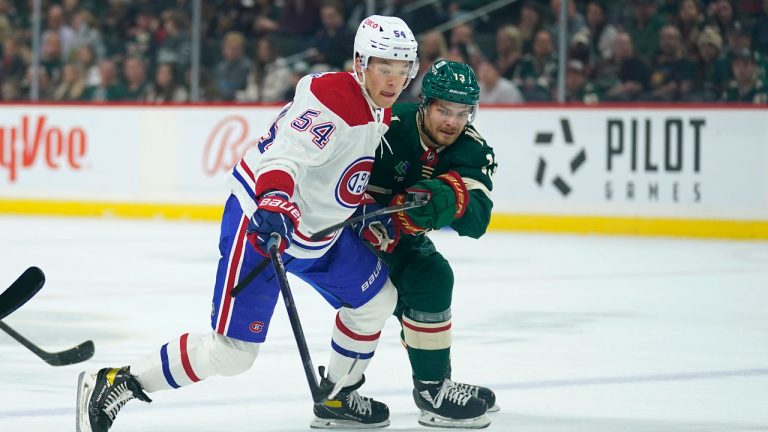
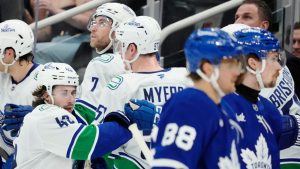
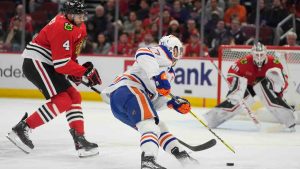
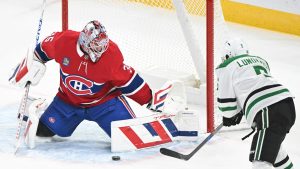

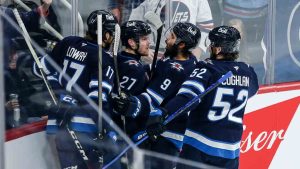
COMMENTS
When submitting content, please abide by our submission guidelines, and avoid posting profanity, personal attacks or harassment. Should you violate our submissions guidelines, we reserve the right to remove your comments and block your account. Sportsnet reserves the right to close a story’s comment section at any time.